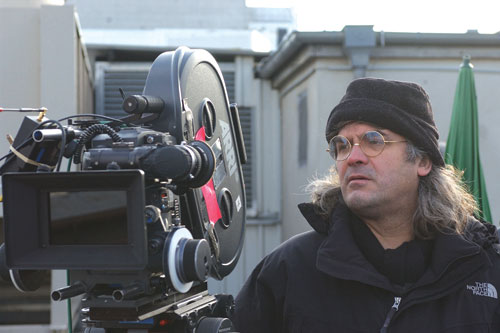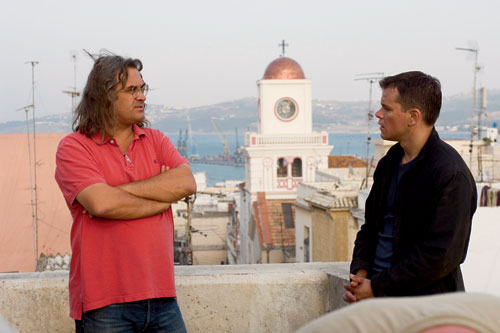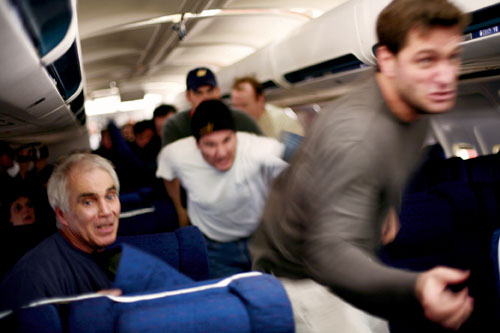BY JOHN PATTERSON
 THE REALITY ADAPTER: Greengrass adapts the techniques of British
THE REALITY ADAPTER: Greengrass adapts the techniques of British
documentary filmmaking to create a new sense of reality.
(© Jasin Boland/Universal Pictures)"Deep down," says British director and DGA member Paul Greengrass, "all directors feel like frauds—because it's built into the nature of the job. You're the jack of all trades and the master of none. The cameraman knows the camera, the sound man knows the sound equipment—and you? You can't do anything: You can't do the acting, you can't dress the set, you don't record the sound or shoot the images. It's a weird job and at the heart of every director—well, at the heart of me, anyway—there's that nagging feeling that, any minute now, someone's going to walk on the set and say, 'Excuse me, what are you doing here? Everyone else here is making a movie, but what are you doing?' And when you're asked that question, you stutter, 'I d-d-d-dunnno!'"
Ah, but he does know, as is proven by the string of politically alert, highly convincing and utterly thrilling docudramas Greengrass has made over the last decade, including Bloody Sunday, his moment-by-moment reconstruction of the 1972 massacre of 13 unarmed civil rights marchers in Derry and, more recently, United 93, his masterful conjecture on the fate of the passengers on the hijacked plane on 9/11 that failed to reach its intended target, thanks to an insurrection by its passengers. At the moment however, he's on a short hiatus from The Bourne Ultimatum, third in the Bourne franchise, and the second in the series that Greengrass has directed.
He is a burly, gregarious man, a youthful-looking 52 with Lennon-esque, gold-rimmed spectacles and very '70s hair. We meet in his idyllic hometown of Henley-upon-Thames, about 40 miles upriver from London. He chats at length, and with enviable precision, about his work, his influences, his filmmaking style, and his unusual path to Hollywood.
Unlike many directors, Greengrass' background is not in features or television or stage drama. "I had absolutely no theatrical experience with actors whatsoever," he says, "but I knew how to tell a story." Instead, he learned his craft in the highest reaches of British television journalism, having spent his first decade after graduating from Cambridge University as a researcher and writer-producer-director on Granada Television's legendary current affairs program World in Action, whose earlier alumni also included the "Three Mikes"—Newell, Apted and Hodges.
"It's now sadly long gone," says Greengrass, "but for 30 years it was a documentary current affairs program that ran on independent television, and was essentially a film program. It didn't have reporters doing pieces to camera. Its roots reached back to the beginning of the British documentary tradition. It was an eclectic mix of filmmaking, radical politics and exemplary investigative journalism. Twenty or 30 people making films from all over the world and in our own backyard, fired by a tremendous sense of mission."
It was a punishing but invigorating workplace. "I spent my 20s making film after film, often in very adverse conditions. You'd fly back from somewhere—Beirut, the Falklands, South Africa—on Saturday and you'd have 24 hours to cut your film and it would go out on Monday night. When I look back now on the ferocity of the technical demands, it wasn't like today when you shoot on tape. You had to plan ahead, you had to think in film terms. It also taught me the absolutely critical virtue of working in a team, because it was a team culture."
At the same time, Greengrass admired other British filmmakers who, in a kind of reversal of the World in Action approach, were superimposing documentary realism onto fictional, albeit politically charged projects. Among his idols were such legendary BBC directors as Ken Loach, Peter Watkins and the late Alan Clarke, a fiery poet of masculine brutality and institutional violence who was Britain's first genius of the Steadicam—Greengrass' own camera of choice. Their methods can clearly be seen in all of his movies, both for TV and Hollywood.
 FOCUSED: In The Bourne Ultimatum with Matt Damon, Greengrass
FOCUSED: In The Bourne Ultimatum with Matt Damon, Greengrass
turns the documentarist's observational eye on a dramatic canvas.
(© Jonathan Olley/Universal Pictures) ROLLING: Greengrass shot grueling 20-minute takes that were cut together
ROLLING: Greengrass shot grueling 20-minute takes that were cut together
for the climax of United 93. (© Jasin Boland/Universal Pictures)He has called Loach's 1969 drama Kes his favorite movie and, despite lacking Loach's theatrical training, Greengrass' ensemble work with amateur and professional actors derives directly from his example. And his preference for recreated political events using handheld cameras and the visual techniques of newsreels owes much to Watkins' visceral, kinetic approach, which he cites as hugely important to his own development.
As for many British directors, including Michael Winterbottom and Danny Boyle, the less well-known Clarke was a model for Greengrass. "The most influential British filmmaker, bar none, we all walk in his footsteps," he says of Clarke, who died in 1990. Clarke used gliding Steadicam tracking shots whose precision contrasted starkly with the untidy, violent events they capture in locations like Northern Ireland and elsewhere. Greengrass' own camera style is intentionally more jerky, preferring "lots of handheld, and as much natural light as possible, getting into the thick of things, accidental-seeming, where luck comes into play, as well as good judgment."
Following the example of his admired directors, Greengrass saw a place for his own emerging aesthetic; and when he felt he'd learned all he could at World in Action, he jumped ship to features. His first film, Resurrected (1989), told the (mostly) true story of a young soldier who vanished mid-battle in the Falklands, and declared MIA, was buried with full military honors and acclaimed a hero, only to show up 42 days later, apparently suffering from amnesia and post-traumatic stress disorder. The film culminates with a brutal mock court martial conducted by the soldier's drunken platoon in the barracks.
"With the dramatic canvas I found you could still operate with the documentarist's observational eye," explains Greengrass. "You could never have witnessed this scene with a documentary camera. No one's ever going to let you see that, yet by using actors and drama you could create this event and try to record it as if it were real. Somehow the complexity of the larger event was encoded in the tiny moment that we were portraying. The collision between the two allows you to get at a bigger truth than you could by using just the one or the other."
Greengrass acknowledges that his is "a different aesthetic which is, I hope, reasonably unvarnished. I prize something that feels authentic. It's an undefinable thing but I know it when I see it, and I think audiences do, too. One of the reasons why Bloody Sunday and United 93 work is because they felt real, felt truthful."
One of the techniques Greengrass frequently uses to create this intimacy and reality is fantastically long takes—some lasting up to 50 minutes—within tightly circumscribed sets like the interior of a 757 or a dilapidated public housing estate in Dublin. This allows the director's well-drilled but improvising cast to run freely through their often chaotic duties as the cameras roll. Of the grueling, 20-minute takes that were later cut together for the climax of United 93, producer Lloyd Levin has said, "It was like asking actors to perform the end of A Long Day's Journey Into Night over and over again."
Much of what gives Greengrass' work its realism occurs in preproduction. He does intense background research with eyewitnesses and has emotional interaction with people involved in the real events or with their survivors. "It's the essential foundation. You can't make those films correctly unless you have their consent and support," he says.
Greengrass is always keen to imbue his casts with a collective sense of mission and togetherness, discussing the script with them in detail and rehearsing intensively for several weeks before the cameras roll. His casting process mixes amateurs with a smattering of professionals and favors people who have in their real lives experienced events like those unfolding on screen. Thus, real paratroop veterans of Northern Ireland played the soldiers in Bloody Sunday, and some of the victims were played by their own relatives. Likewise, many of the air-traffic controllers and flight stewards in United 93 had a connection to the horrible events. As Greengrass says, "They often already understand these experiences, professionally or emotionally, from the inside," unlike actors, who have to learn it from scratch.
Above all, Greengrass seeks a fluid, open-ended filmmaking process that allows for improvisation and the happy accident. His camera often lurks at the fringes, as if catching the actors unaware, shuddering and gliding amongst them, shifting from character to character and creating "a very immediate and direct feeling, an emotional truthfulness, as if the camera was right in there as a participant."
This is less the case in his Bourne features, although the wandering camera often treats household-name movie stars as if they're extras. Still, one doubts there are many star-fits about close-up allocation on a Greengrass set.
In Bloody Sunday, one crucial killing is obscured by an actor's head in the foreground at what any other director might feel was exactly the wrong moment, but as Greengrass says, it had an "accidental, newsreel quality and greater authenticity. I like things to feel unconsidered, to make you feel like you're an active participant in the events. So I don't worry too much if the photography loses its formal perfection."
This hardly sounds like a director Hollywood would be interested in, but, much to his amazement, after the success of Bloody Sunday, he was courted to direct The Bourne Supremacy. "It was nothing that I'd ever even thought of. You wouldn't think looking at my films, 'Oh, there's a guy who's going to Hollywood.' And the choice to make a film about a civil rights massacre in Northern Ireland 30 years ago isn't exactly a bid for commercial stardom."
Not that the transition wasn't challenging. "Going from my kind of movie to a big-budget Hollywood movie is like moving from a very small Piper Cherokee to a 747," he says, "but structurally, Bourne is a collision between a mainstream sensibility and an indie sensibility. The two have got to collide, and we spend time to create conditions where it's not all cut-and-dried. You've got to leave enough of it in flux so that you can find it as you go along."
He mentions the memorably claustrophobic fight in a suburban kitchen in The Bourne Supremacy as one example of a moment dreamed up on the set. In the scene, Matt Damon blows up an apartment with an improvised time delay by stuffing a magazine into a toaster and then severing a gas pipe that the burning magazine will inevitably ignite.
"Someone says, 'Oh, what if we do this...?' It happens all the time. Right up to the last moment it's still all up for grabs and that can make it hairy, but that's the sweet place where the precious stuff is," says the director.
So, with all he's accomplished—Bloody Sunday won the Audience Award at Sundance and he was nominated for an Oscar for directing United 93—does the occasional feeling of fraudulence still persist?
"That feeling's always there, but you develop more of a sense of confidence about it. You feel a sense of authority because now you clearly do know what you're doing. The thing people never say about directing is that it's a great deal about practice. The more you do it, the more competent you become; the more you know what you're doing, the more you learn what you can't do."